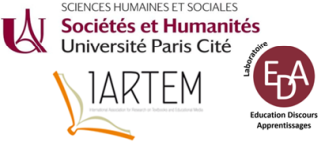Based on the meaning of science for all and literacy-oriented instruction, the General Guidelines of 12-year Basic Education suggested that all students must elect the subject of Earth Science at least two credits in high school (TMOE, 2018). For this purpose, all high school students can possess the scientific literacy to retain problem-solving skills and deal with the issues in their daily lives (NGSS Lead States, 2013), such as the issue of climate change. However, Climate Change is a complex concept because it is affected by the global system and the whole earth system. Thus, the textbook in Earth Science provides features to support high school students learning about climate change, especially in evaluating their learning.
This study investigates the facilitation of multiple representations in high school textbook exercises on students' learning in climate change. Specifically, the analysis was guided by the following research questions: RQ1. Is the concept of climate change a complex system? RQ2. Do the multiple representations facilitate assessing the student's performance on the exercises of complex systems such as climate change? RQ3. What are the differences in the exercise items on climate change in different curriculum guidelines?
In response to the research questions, the current study focused on the four publishers' Earth Science textbooks and collected the exercise items of the Climate Change chapter. A total of 96 items (2019 version:40; 2009 version:56) were analyzed by the content analysis. The three coding schemes were utilized to realize the relationships among the cross-domain concepts, the inquiry practices, and the representations. For example, an item from the T2 publisher's 2019 version presents a table with the number of days and peak temperatures (highest and lowest temperatures) in winter and summer at the four measuring stations from 1957 to 2006 (also see supplementary). Then, the task required students to respond to two items: (1) What is the title of this research? (2) Please discuss this table and state at least two points about the phenomenon observed from the data. In this situation, the first item was coded in the "interactions" of cross-domain concepts, with the inquiry practice of "questioning" and the "statistics table" representation. On the other hand, the second item gets the codes of "interactions," "reasoning," and "statistics table."
The findings revealed that the concept of climate change is relatively complex and needs a comprehensive application of knowledge within the Earth Science knowledge system. Examination questions about climate change mainly encompass knowledge concepts spanning cross-disciplines, particularly addressing the themes of "interactions" and "changes and stability."
When solving problems, the findings also indicate that students do not rely on extracting singular knowledge, rather than applying what they have learned and integrating various cross-disciplinary concepts—a more appropriate representation, such as the statistic chart or data table. Thus, learners can demonstrate integration skills to make their claim about climate change.
Moreover, the proportion of questions requiring comprehensive application has gradually increased, contrasting with the predominantly textual and recalling questions in the previous curriculum (2009 version). Simultaneously, the research analysis reveals that, due to the new curriculum's requirements, the latest questions are beginning to incorporate topics that integrate the nature of science and cultivate students' interest in science.
Since the concept of climate change is a complex system, the representations may facilitate students to realize the interactions and changes of variables in the earth system. This study suggests the importance of the implications for textbook researchers and designers that utilize multiple representations to assess student learning and allow them to self-evaluate.
Reference
NGSS Lead States. (2013). Next generation science standards: For states, by states. National Academies Press.
Taiwan Ministry of Education. (2018). General Guidelines of 12-year Basic Education. Taiwan Ministry of Education. https://www.naer.edu.tw/eng/PageSyllabus?fid=148
- Picture

 PDF version
PDF version

